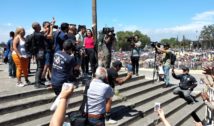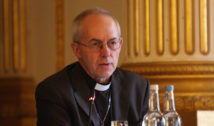What Happened at the Council of Nicaea? by By L. Arik Greenberg
- By WRN Guest --
- 03 Apr 2020 --
![]() I often hear people speak in hushed and conspiratorial tones — as if they were divulging a well-guarded secret — about how the Catholic Church changed the entire tenor of true Christianity following the Council of Nicaea and how at that ecumenical council they voted on and fundamentally changed the contents of the entire Bible as we know it. Occasionally, I have heard this from academics as well — not New Testament scholars, of course, since we know better than this. Where did this fundamental misinformation about Nicaea come from? Large numbers of people in the current generation have learned of it from Dan Brown’s Da Vinci Code, but he didn’t invent it. It was around for at least a generation before that, popularized by self-proclaimed independent scholars, many of whom were merely investigative journalists, and not even good ones at that. Why did anyone believe them? Because people like a good scandal. People like to think that they have gained access to closely guarded secrets, the real truth behind the official story. This is where Dan Brown came in — he knew how to capitalize upon this natural human tendency.
I often hear people speak in hushed and conspiratorial tones — as if they were divulging a well-guarded secret — about how the Catholic Church changed the entire tenor of true Christianity following the Council of Nicaea and how at that ecumenical council they voted on and fundamentally changed the contents of the entire Bible as we know it. Occasionally, I have heard this from academics as well — not New Testament scholars, of course, since we know better than this. Where did this fundamental misinformation about Nicaea come from? Large numbers of people in the current generation have learned of it from Dan Brown’s Da Vinci Code, but he didn’t invent it. It was around for at least a generation before that, popularized by self-proclaimed independent scholars, many of whom were merely investigative journalists, and not even good ones at that. Why did anyone believe them? Because people like a good scandal. People like to think that they have gained access to closely guarded secrets, the real truth behind the official story. This is where Dan Brown came in — he knew how to capitalize upon this natural human tendency.
When I first began teaching New Testament on the college level in 2003, I was just finishing my Ph.D. and the DaVinci Code was all the rage. It was so popular that even students — who ironically are notorious non-readers — were reading it in droves, rather than reading our class textbook. One such student, in a Hail-Mary attempt to B.S. her way out of having underprepared for the final exam, referred in one of her essays to “scholar Dan Brown,” much to my chagrin and horror. By that point, I had spent over a decade in seminary and graduate school, earning multiple degrees in the very field that Dan Brown was writing fiction about. A novelist with no formal education in Biblical Studies was making millions by mis-informing my students and the general public. I concluded that I must be in the wrong field.
Dan Brown is not a scholar; he is a fiction writer who has gotten rich from exploiting people’s ignorance and their hunger for a juicy scandal, and has mis-educated millions in the process. His books are highly entertaining, but they are not the product of serious scholarship on the subject. Rather, they are the product of reading the most extreme forms of fanciful pop-scholarship and weaving it together as if the alternate version of history were the hidden truth. While these may pose and give voice to important, long-suppressed questions, challenging some of the established teachings about Christian history, they offer preposterous and unfounded answers to those questions.
What this tells me is that there is a disconnect between academia and the general public. While the average person is hungry for knowledge — just observe the success of the History Channel and the Great Courses series, among other informational content — the Ivory Tower model of higher education has not actively engaged the general public in a satisfactory and successful manner. People want to learn, but there is a dearth of public intellectuals who can explain hard concepts in a manner easy for everyone to understand. This is where Dan Brown fills a need. Scholars have a responsibility to educate not only their students, or to interface and debate with other scholars through academic papers and books read only by other scholars, but they need to make their work available, accessible, and interesting to everyone, so that those outside of academe will want to learn from them. Few scholars have done this. In my field, people like Burton Mack, John Dominic Crossan, and Bart Ehrman are among those few.
So what was so wrong about Dan Brown’s reconstruction of history? To answer this, I thoroughly recommend Bart Ehrman’s Truth and Fiction in the Da Vinci Code as a companion to reading the DaVinci Code. Ehrman is one of the most widely read scholars of New Testament, who literally wrote the textbook, as they say, since his introductory textbook is probably the most widely used among undergraduate New Testament courses. He finds a way to make hard concepts easy to understand. And while as a former evangelical, he is no favorite of conservative Christians, his scholarship is solid and much of his publication consists of merely reporting on what the majority of serious NT scholars have presented over the past century and a half. And his presentation of it is enjoyable and challenges the reader to think critically about concepts we have been taught to believe as true. In Truth and Fiction …, Ehrman takes the time to explain the history behind Brown’s assertions, and does it in a way that doesn’t take away from the joy of reading Brown’s story, as he also confesses to enjoying it.
Among the many things that Ehrman talks about in Truth and Fiction… is the Council of Nicaea. And his reports are no different than the conservative Christian recollection of the history of the Church, presented in Eusebius’ Historia Ecclesia, so this is not a point of conflict to trust his words here. Other scholars have talked about it, too. The reports of its proceedings have never been secret. So why does everyone seem to want to re-explain the truth of what happened at Nicaea? And what really happened there?
The major categories of things they deliberated and resolved included: (1) various matters of church discipline, including what to do with apostates now that the persecution of Christians had ended following Constantine’s conversion to Christianity and his proclamation of toleration of Christianity; (2) the nature of Christ, whether he was fully divine or not, co-equal to the father or a creation thereof; and (3) the official date of Easter. That’s it. They never discussed or voted on the contents of the Bible. The contents of the NT had already been largely stabilized by consensus over the previous two centuries, with some notable exceptions. And although there were still a number of versions of the NT canon being used in different parts of the Roman Empire, these were not nullified by the Council. They continued to exist and flourish for another couple of centuries. In fact, the version of the NT that we have canonized in today’s Bible was proposed by Bishop Athanasius of Alexandria in 367 AD, a full four decades after Nicaea. And this still didn’t stop other Christians from using divergent canons, as if people suddenly all rejoiced and complied as soon as Athanasius’ canon became public.
Then where does the connection between the Biblical canon and Nicaea come from? Constantine asked Eusebius of Caesarea at a later time for 50 copies of the Christian Bible in order to outfit the new churches in Constantinople. Eusebius’ canon appears to have had some notable differences from ours. And a noteworthy contemporary complete copy of the Bible known as Codex Vaticanus also has significant differences from the modern NT canon, although the basic bones are already in place, showing large agreement on the four canonical gospels. And for the next few centuries, Christians continued to use divergent NT canons, with little or no attention paid to Athanasius’ creation of what ultimately would become today’s NT canon. Perhaps this is the kernel of truth that gave rise to people’s mistaken belief that Constantine must have meddled with the contents of the Bible.
None of this, of course, addresses the persistent, remaining disagreements between Protestants, Catholics, and Orthodox Christians as to what comprises the Old Testament. The existence of the nearly two dozen texts from the intertestamental period that Protestants reject and term the “Apocrypha,” but which Catholics and Orthodox Christians believe to be part of their Old Testament, is in itself a testament to the fact that nobody voted on, or suddenly and scandalously changed, amidst conspiracy, the contents of the original Bible.
———————-
1. Ehrman, Bart (2004), Truth and Fiction in the Da Vinci Code, Oxford University Press, ISBN 978-1-280-84545-1.
2. Truth and Fiction in the Da Vinci Code, pp. 15-16, 23, 93.
3. MacDonald, Lee M., and Sanders, James A., The Canon Debate, Hendrickson Publishers, 2002 ISBN 978-0801047084, pp. 591-597.



















